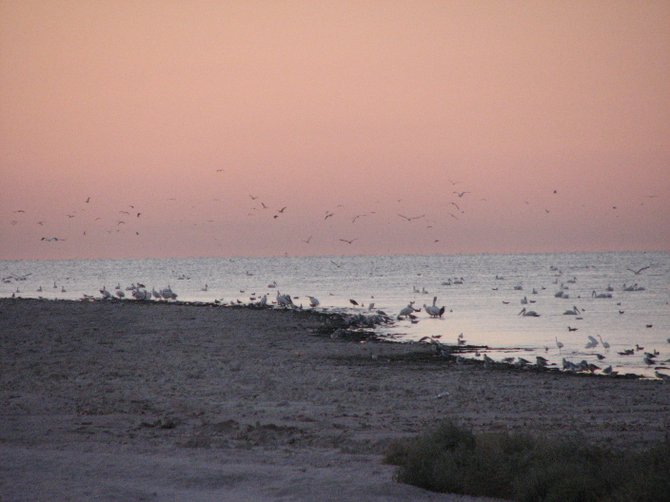 Facebook
Facebook
 X
X
 Instagram
Instagram
 TikTok
TikTok
 Youtube
Youtube

I rolled my Celica up to the Border Patrol guards stopping traffic along Route 111 north of El Centro. When asked where I was headed, I explained that I was here to see “their” sea. As the guard with the German Shepard whose head easily met mine through the opened window circled the car, the one holding my license laughed and said, “Oh yeah? What do you think of our sea so far?”
The sun was just beginning to set beyond one of the five volcanic domes located in the southwestern part of the Salton Sea. “Beautiful,” I replied, which earned me even more laughing.
The Salton Sea lies along the San Andreas Fault, which explains the volcanic cones, as well as the mud geysers and other geothermal activity prevalent throughout the area. Although its salinity is 25 percent higher than that of the ocean, it is officially a lake – the largest lake in California in fact. It’s also 227 feet below sea level.
A critical part of the Pacific Flyway, it is frequented by more than 70,000 birds, including white and brown pelicans, white-faced ibis and wood storks. More than 80 percent of existing American white pelicans use the Sea, which also has the largest breeding colony of double-breasted cormorants on the West Coast.
They come for the fish, the majority of which is tilapia, a non-native freshwater fish that also happens to be a prolific breeder. Although the Sea is as clean as Lake Tahoe, its high salinity holds less oxygen. As one of the most productive fisheries in the world, die-off cycles are natural. (Due to the heat, the dead fish dehydrate quickly, thankfully.)
I pulled in to my campsite in time to catch the last rays of the sun setting over the Santa Rosa Mountain Range to the west. I would sleep well and wake at dawn to see the birds and Sea in its full glory. Or so I thought. There are more than 2,000 campsites along the Salton Sea and I had chosen one that backed up to the highway and train track. Figures.
As I crawled out from my tent at dawn, I could hear the birds in the shadows and mist still hugging the shoreline. When the fog rose, I was stunned to see thousands of birds between me and the rose-colored Santa Rosas.
There were full skeletons and dehydrated carcasses of dead fish along the shores, but not as many as I’d been warned there would be. And there was absolutely no smell of decay. Just healthy sea smells. Numerous nests indented the shoreline. Life not only existed but propagated here at what so many think is a dead inland sea.
And, I did not see boats on the Sea. Perhaps officials wisely limit the seasons that motorized boats can be used due to marine bird breeding. All the more reason to visit the Sea in the cooler, less populated off-season.


I rolled my Celica up to the Border Patrol guards stopping traffic along Route 111 north of El Centro. When asked where I was headed, I explained that I was here to see “their” sea. As the guard with the German Shepard whose head easily met mine through the opened window circled the car, the one holding my license laughed and said, “Oh yeah? What do you think of our sea so far?”
The sun was just beginning to set beyond one of the five volcanic domes located in the southwestern part of the Salton Sea. “Beautiful,” I replied, which earned me even more laughing.
The Salton Sea lies along the San Andreas Fault, which explains the volcanic cones, as well as the mud geysers and other geothermal activity prevalent throughout the area. Although its salinity is 25 percent higher than that of the ocean, it is officially a lake – the largest lake in California in fact. It’s also 227 feet below sea level.
A critical part of the Pacific Flyway, it is frequented by more than 70,000 birds, including white and brown pelicans, white-faced ibis and wood storks. More than 80 percent of existing American white pelicans use the Sea, which also has the largest breeding colony of double-breasted cormorants on the West Coast.
They come for the fish, the majority of which is tilapia, a non-native freshwater fish that also happens to be a prolific breeder. Although the Sea is as clean as Lake Tahoe, its high salinity holds less oxygen. As one of the most productive fisheries in the world, die-off cycles are natural. (Due to the heat, the dead fish dehydrate quickly, thankfully.)
I pulled in to my campsite in time to catch the last rays of the sun setting over the Santa Rosa Mountain Range to the west. I would sleep well and wake at dawn to see the birds and Sea in its full glory. Or so I thought. There are more than 2,000 campsites along the Salton Sea and I had chosen one that backed up to the highway and train track. Figures.
As I crawled out from my tent at dawn, I could hear the birds in the shadows and mist still hugging the shoreline. When the fog rose, I was stunned to see thousands of birds between me and the rose-colored Santa Rosas.
There were full skeletons and dehydrated carcasses of dead fish along the shores, but not as many as I’d been warned there would be. And there was absolutely no smell of decay. Just healthy sea smells. Numerous nests indented the shoreline. Life not only existed but propagated here at what so many think is a dead inland sea.
And, I did not see boats on the Sea. Perhaps officials wisely limit the seasons that motorized boats can be used due to marine bird breeding. All the more reason to visit the Sea in the cooler, less populated off-season.